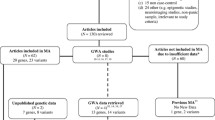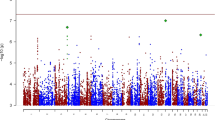Abstract
Following our recent finding of Rgs2 playing a role in the development of human panic disorder (PD), we examine another positional and functional candidate from the functionally interwoven Rgs (regulator of G-protein signaling) family, Rgs7, in the pathogenesis of PD. A German PD sample (N = 224) was compared with matched controls (N = 224) for seven SNPs within and flanking the gene. The intronic SNP3 (rs11805657) and its corresponding haplotypes were found to be associated with PD, particularly PD with comorbid agoraphobia (PDAgP), with the effect originating from the female subgroup (P values 0.008–0.047). The rare A-allele was underrepresented in patients, suggesting a protective effect with carriers possessing an about 2-fold lower risk for developing the disorder compared to G/G homozygotes. Our results argue against a major role of Rgs7 gene variants in the pathogenesis of PD, but are consistent with a minor gender-specific effect on PD, particularly PDAgP.

Similar content being viewed by others
References
Barrett JC, Fry B, Maller J et al (2005) Haploview: analysis and visualization of LD and haplotype maps. Bioinformatics 21:263–265
Cartharius K, Frech K, Grote K et al (2005) MatInspector and beyond: promoter analysis based on transcription factor binding sites. Bioinformatics 21:2933–2942
Crowe RR, Goedken R, Samuelson S et al (2001) Genomewide survey of panic disorder. Am J Med Genet 105:105–109
Cui H, Nishiguchi N, Ivleva E, Yanagi M, Fukutake M, Nushida H, Ueno Y, Kitamura N, Maeda K, Shirakawa O (2007) Association of RGS2 gene polymorphisms with suicide and increased RGS2 immunoreactivity in the postmortem brain of suicide victims. Neuropsychopharmacology 33(7):1537–1544
Deckert J, Catalano M, Syagailo YV et al (1999) Excess of high activity monoamine oxidase A gene promoter alleles in female patients with panic disorder. Hum Mol Genet 8:621–624
Domschke K, Freitag CM, Kuhlenbaumer G et al (2004) Association of the functional V158M catechol-O-methyl-transferase polymorphism with panic disorder in women. Int J Neuropsychopharmacol 7:183–188
Ebihara M, Ohba H, Hattori E et al (2003) Transcriptional activities of cholecystokinin promoter haplotypes and their relevance to panic disorder susceptibility. Am J Med Genet B Neuropsychiatr Genet 118:32–35
Fyer AJ, Hamilton SP, Durner M et al (2006) A third-pass genome scan in panic disorder: evidence for multiple susceptibility loci. Biol Psychiatry 60:388–401
Gelernter J, Bonvicini K, Page G et al (2001) Linkage genome scan for loci predisposing to panic disorder or agoraphobia. Am J Med Genet 105:548–557
Goodwin RD, Faravelli C, Rosi S et al (2005) The epidemiology of panic disorder and agoraphobia in Europe. Eur Neuropsychopharmacol 15:435–443
Greenbaum L, Strous RD, Kanyas K, Merbl Y, Horowitz A, Karni O, Katz E, Kotler M, Olender T, Deshpande SN, Lancet D, Ben-Asher E, Lerer B (2007) Association of the RGS2 gene with extrapyramidal symptoms induced by treatment with antipsychotic medication. Pharmacogenet Genomics 17:519–528
Gu S, Anton A, Salim S, Blumer KJ, Dessauer CW, Heximer SP (2007) Alternative translation initiation of human RGS2 yields a set of functionally distinct proteins. Mol Pharmacol 73(1):1–11
Hamilton SP, Slager SL, Heiman GA et al (2002) Evidence for a susceptibility locus for panic disorder near the catechol-O-methyltransferase gene on chromosome 22. Biol Psychiatry 51:591–601
Hamilton SP, Slager SL, De Leon AB et al (2004) Evidence for genetic linkage between a polymorphism in the adenosine 2A receptor and panic disorder. Neuropsychopharmacology 29:558–565
Hettema JM, Neale MC, Kendler KS (2001) A review and meta-analysis of the genetic epidemiology of anxiety disorders. Am J Psychiatry 158:1568–1578
Jiang X, Xu K, Hoberman J et al (2005) BDNF variation and mood disorders: a novel functional promoter polymorphism and Val66Met are associated with anxiety but have opposing effects. Neuropsychopharmacology 30:1353–1361
Kaabi B, Gelernter J, Woods SW et al (2006) Genome scan for loci predisposing to anxiety disorders using a novel multivariate approach: strong evidence for a chromosome 4 risk locus. Am J Hum Genet 78:543–553
Kehrl JH, Sinnarajah S (2002) RGS2: a multifunctional regulator of G-protein signaling. Int J Biochem Cell Biol 34:432–438
Kendler KS, Karkowski LM, Prescott CA (1999) Fears and phobias: reliability and heritability. Psychol Med 29:539–553
Knowles JA, Fyer AJ, Vieland VJ et al (1998) Results of a genome-wide genetic screen for panic disorder. Am J Med Genet 81:139–147
Larminie C, Murdock P, Walhin JP et al (2004) Selective expression of regulators of G-protein signaling (RGS) in the human central nervous system. Brain Res Mol Brain Res 122:24–34
Leygraf A, Hohoff C, Freitag C et al (2006) RGS 2 gene polymorphisms as modulators of anxiety in humans? J Neural Transm 113:1921–1925
Mannuzza S, Fyer AJ, Klein DF et al (1986) Schedule for affective disorders and schizophrenia—lifetime version modified for the study of anxiety disorders (SADS-LA): Rationale and conceptual development. J Psychiatr Res 20:317–325
Marinescu VD, Kohane IS, Riva A (2005) MAPPER: a search engine for the computational identification of putative transcription factor binding sites in multiple genomes. BMC Bioinformatics 6:79
Oliveira-dos-Santos AJ, Matsumoto G, Snow BE et al (2000) Regulation of T cell activation, anxiety, and male aggression by RGS2. Proc Natl Acad Sci USA 97:12272–12277
Robins LN, Wing J, Wittchen HU et al (1988) The Composite International Diagnostic Interview. An epidemiologic instrument suitable for use in conjunction with different diagnostic systems and in different cultures. Arch Gen Psychiatry 45:1069–1077
Rosner B (2006) Fundamentals of biostatistics, 6th edn. Duxbury Press, Pacific Grove (CA)
Ross EM, Wilkie TM (2000) GTPase-activating proteins for heterotrimeric G Proteins: regulators of G protein signalling (RGS) and RGS-like proteins. Annu Rev Biochem 69:795–827
Smoller JW, Paulus MP, Fagerness JA, Purcell S, Yamaki LH, Hirshfeld-Becker D, Biederman J, Rosenbaum JF, Gelernter J, Stein MB (2008) Influence of RGS2 on anxiety-related temperament, personality, and brain function. Arch Gen Psychiatry 65:298–308
Thorgeirsson TE, Oskarsson H, Desnica N et al (2003) Anxiety with panic disorder linked to chromosome 9q in Iceland. Am J Hum Genet 72:1221–1230
Tishkoff SA, Pakstis AJ, Ruano G, Kidd KK (2000) The accuracy of statistical methods for estimation of haplotype frequencies: an example from the CD4 locus. Am J Hum Genet 67:518–522
Watson N, Linder ME, Druey KM et al (1996) RGS family members: GTPase-activating proteins for heterotrimeric G-protein alpha-subunits. Nature 383:172–175
Weissman MM, Bland RC, Canino GJ et al (1997) The cross-national epidemiology of panic disorder. Arch Gen Psychiatry 54:305–309
Wittchen HU (1997) SKID-I: strukturiertes klinisches Interview für DSM-IV, Achse I: Psychische Störungen. Hogrefe, Goettingen
Yalcin B, Willis-Owen SAG, Fullerton J, Meesaq A, Deacon RM, Rawlins JN, Copley RR, Morris AP, Flint J, Mott R (2004) Genetic dissection of a behavioral quantitative trait locus shows that Rgs2 modulates anxiety in mice. Nat Genet 36:1197–1202
Acknowledgments
We gratefully acknowledge the skillful technical support by Ms. Kathrin Schwarte.
Author information
Authors and Affiliations
Corresponding author
Additional information
Dedicated to the special issue on Anxiety.
Rights and permissions
About this article
Cite this article
Hohoff, C., Neumann, A., Domschke, K. et al. Association analysis of Rgs7 variants with panic disorder. J Neural Transm 116, 1523–1528 (2009). https://doi.org/10.1007/s00702-008-0097-5
Received:
Accepted:
Published:
Issue Date:
DOI: https://doi.org/10.1007/s00702-008-0097-5




